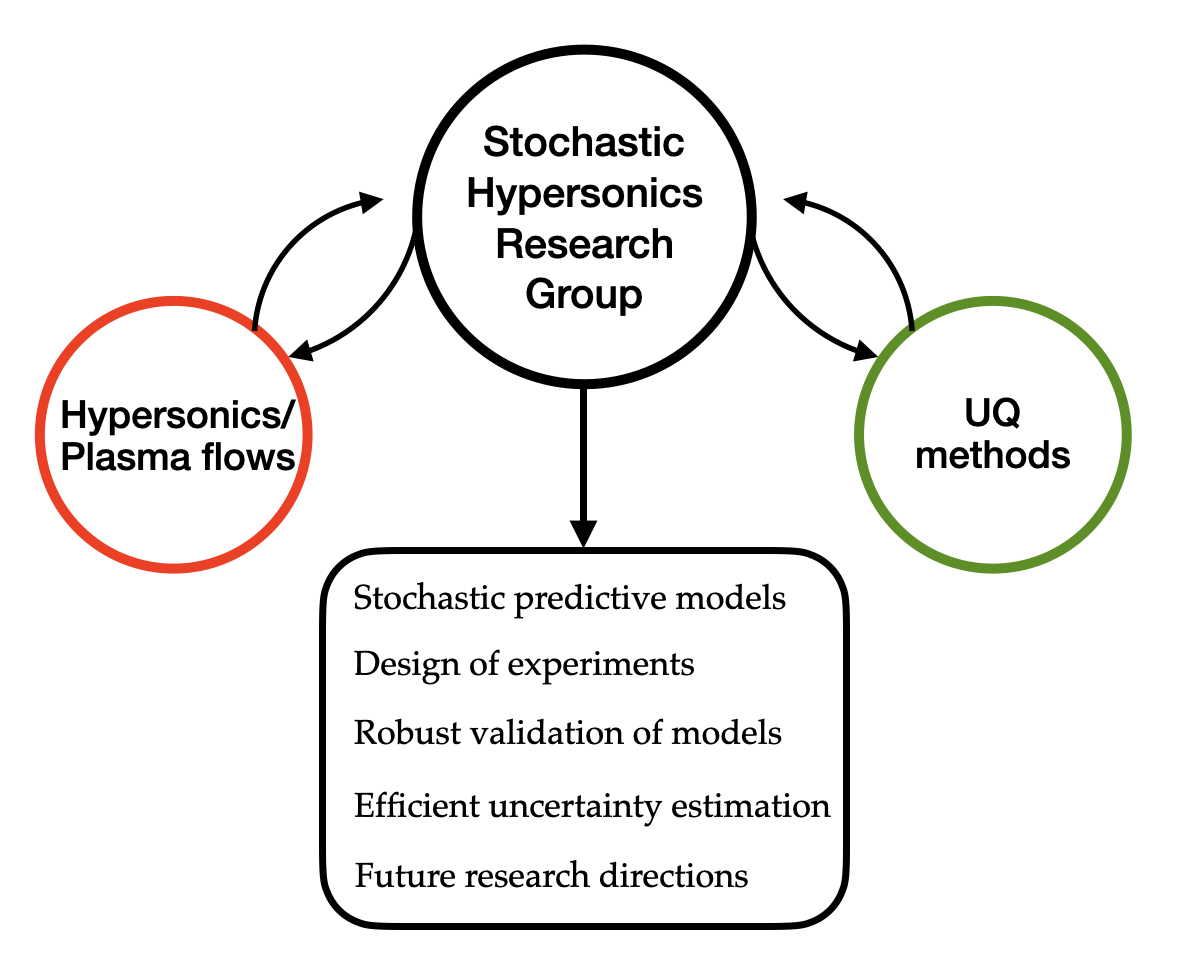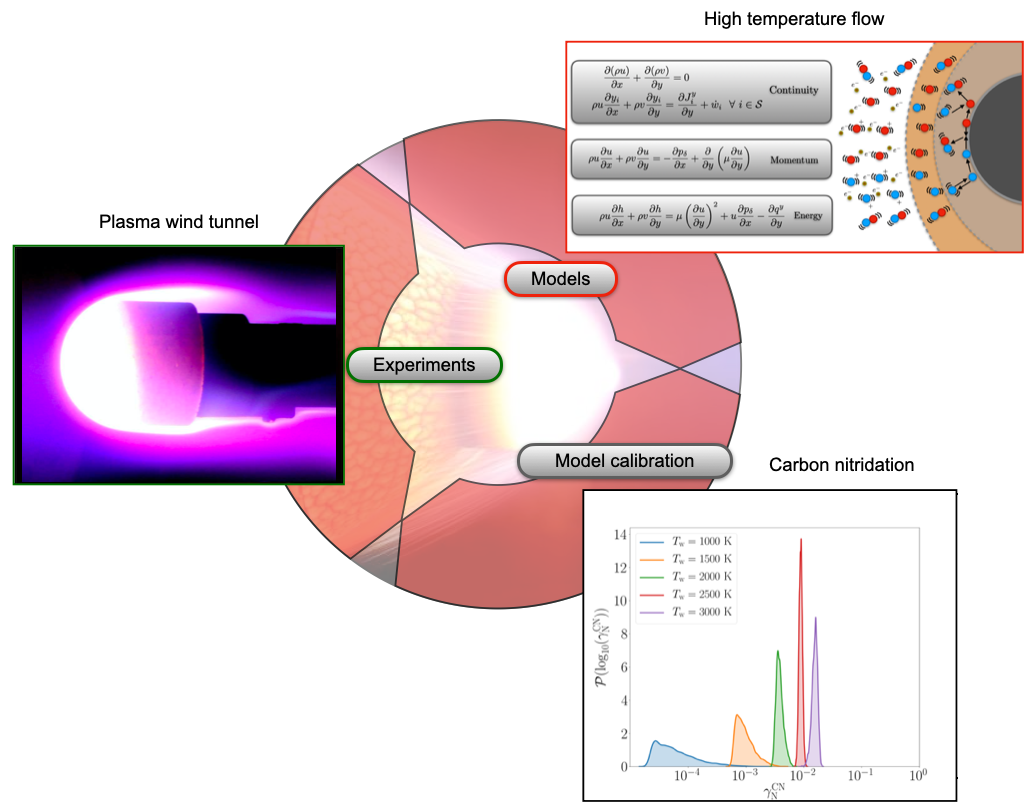Research
Modeling uncertainty is one of the key challenges in hypersonics today. Only a handful of all the produced research include uncertainty as a modeled component. New, surprising insights are being gained by trying to attain some objectivity in model calibration and validation tasks. As an interesting side note, the natural sciences (e.g. Physics, Astronomy, Astrophysics, Particle Physics, etc) have already understood this since quite some time. Actually, most of the recent notable discoveries in Science (e.g. gravitational waves, Higgs boson, etc) could claim that “something new has been discovered” only by using rigorous uncertainty and Bayesian inference analyses to show the confidence in their results. It is very interesting to see that Nobel Prize-worthy research papers are like a masterclass in Bayesian inference techniques. However, we in engineering disciplines have been running quite behind on this matter. Once our disciplines have reached a substantial level of complexity, ad-hoc techniques used to guide experiments and validate models are no longer reliable. This complexity pushes us to embrace more mathematically rigorous techniques that can unbiasedly look at our models, our experiments, and produce reliable estimates of confidence in our predictions.
Every time a scientific paper presents a bit of data, it’s accompanied by an error bar – a quiet but insistent reminder that no knowledge is complete or perfect. It’s a calibration of how much we trust what we think we know. - Carl Sagan
The greatest enemy of knowledge is not ignorance; it is the illusion of knowledge. - Stephen Hawking
Our research uses stochastic methods as the basis for advancing our understanding of hypersonic flows. We are interested in developing stochastic modeling techniques to be applied to a broad range of hypersonic flow problems such as gas-phase chemistry, gas-surface interactions, shock layer radiation, boundary layer transition, etc. We are particularly interested in three aspects of uncertainty modeling: 1) understanding of complex models and their high-order interactions by functional decompositions and sensitivity analyses; 2) using this information to design more informative experiments for model calibration and validation, leading to better utilization of experimental resources; 3) validation of physico-chemical and fluid dynamics models.

Below you can find a list of the ongoing and past research. Come join our team and help us advance the fundamental understanding of hypersonic flows!
Stochastic modeling

Hypersonic flow modeling and experiments are complex. While models require of very different constitutive laws for the accurate simulation of both in-flight and on-ground conditions, experiments cannot measure explicitly all that would be desired for reliable validation. Complex modeling choices together with complex experimental set-ups render the use of off-the-shelf stochastic methods not adequate for hypersonic problems. Our group works on developing stochastic models tailored to hypersonics to produce reliable uncertainty estimations, model calibrations and validations.
High-temperature gas-surface interactions

Characterizing ablation and catalysis phenomena for different atmospheric and material compositions is quite challenging. It is important to understand the coupling mechanisms between material surface properties and the resulting ablation and/or recombination rates which in turn are coupled to flowfield computations. In our group, we explore the possibility of exploiting different sources of experimental data for the purpose of statistically inferring both phenomenological and kinetic models for ablation. In current works, we are able to use experimental data from two very different facilities (molecular beam and plasma wind tunnel) to jointly learn surface chemistry models for nitrogen ablation.
Gas-phase chemical kinetics

We use intrusive measurements in a plasma wind tunnel to learn about gas-phase chemical reactions. Boundary layer modeling requires accurate modeling of backward (e.g. recombination) rates which are generally derived by assuming the principle of detailed balance to be true, possibly giving a biased view on recombination kinetics from shock tube data. In current works, we flip the switch and use experimental data sensitive to boundary layer quantities to obtain calibrated forward rates that, while still relying on the same principle of detailed balance, produce a consistent estimation of backward rates as they are now the drivers of the inference performed with this new set of experimental data. We are also able to prescribe interesting follow-up works that can help in obtaining a rigorous validation of gas-phase chemical models in hypersonic flows.
Free-stream characterization

Currently, the characterization of free-stream conditions in different hypersonic facilities remains very poor. Direct measurements are significantly affected by uncertaintes that are not well characterized, and indirect measurements have to consider a large number of unknowns to produce an estimation. The reliable characterization of free-stream conditions in on-ground facilities remains a challenge and represents one of the biggest roadblocks for validation tasks in hypersonic flows. In our group, we have started tackling this problem in plasma wind tunnels. The first effort was focused on building a low-dimensional stochastic framework. A later work included uncertainties stemming from chemical models, measured boundary conditions and surface response of intrusive probes when the free-stream is to be determined from indirect measurements. Our latest effort focused on introducing and characterizing additional uncertainties stemming from the plasma wind tunnel torch through the use of Gaussian Processes and coupling of different computational solvers (picture courtesy of Vincenzo Romano).
Design of experiments for relevant hypersonic conditions

Calibration and validation of physico-chemical models require of specifically designed experimental data which are rarely considered in themselves. Generally, legacy experimental data or new experimental campaigns targetting a broad spectrum of conditions (generally for more than one purpose) are used for model determination and validation. This approach is problematic as many of the experiments carried out don’t bring any useful information to our models. Furthermore, experimental design is considered only through the lens of a few parameters that are thought to impact the most the outcomes of the measurements and relevant testing environments. This common approach severely impacts how resources are distributed when planning an experimental campaign, and how much information we can retrieve from such experiments. With the advent of high-dimensional stochastic modeling of recent years, we are in a position to break in new ground and challenge the paradigm by which we design our experiments. This leads to a better understanding of the physics in high-speed flows and better utilization of resources to substantially improve the confidence we have in our in-flight predictions.
Hypersonic boundary layer transition

Hypersonic transition is a multiphysics phenomenon that impacts wall heat transfer and skin friction, increasing the drag of the vehicle. Its prediction is a challenging problem dominated by intrinsic uncertainty due to its multiphysics nature. Uncertainty in transition location leads to diminishing vehicle performance. High-temperature effects, body geometry and surface roughness, and overall environment are the general factors that have a great impact on where transition will occur. We are currently focused on developing a stochastic framework that allows us to improve our understanding of transition predictions in hypersonic boundary layers. The ultimate goal is to understand how (and which) wind tunnel tests can inform and improve in-flight probabilistic transition predictions (picture courtesy of Vincenzo Romano).